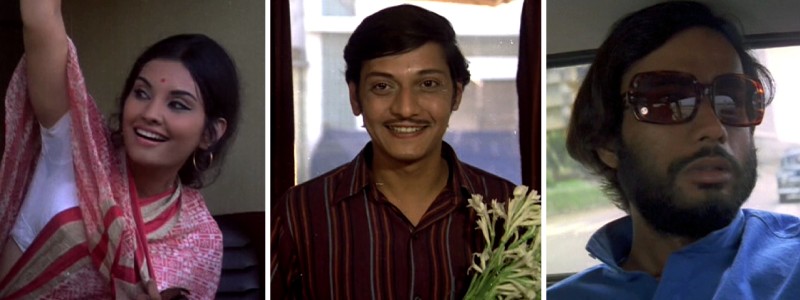When one thinks of the 1970s in Hindi cinema, the image of the Angry Young Man films — exemplified by Amitabh Bachchan in movies such as Deewar — immediately springs to mind. Indeed, the very term Bollywood seems to have been coined for these stylish, over-the-top movies that were so removed from the everyday existence of India — the India in Indian Cinema was somewhere else. And that somewhere else soon started to move into a fringe that people liked to call Art Movies (that later mutated into early 2000s Crossover Movies); I rarely heard the term used without derision, and for the most part 1980s art movies were dull, coma-inducing trips into poverty porn and manner plays.
But in the 1970s there was no such conscious distinction, no strict expectations of angry young men, masala mayhem, or profound artistic realism. So when Beth (of Beth Loves Bollywood) proposed a ’70s week’ of movie-related blogging, I too thought immediately of those wonderfully extravagant 1970s — but I also thought of Rajnigandha.

Basu Chatterjee’s 1974 movie is a simple, straightforward tale of a young woman at an unexpected crossroads in life. Deepa (Vidya Sinha) is a freshly-minted M.A. in New Delhi looking for a teaching job. She’s engaged to Sanjay (Amol Palekar), her former college-mate, but they’re putting off their wedding until she can finish her PhD, and he can secure a much-wanted promotion at his bank.
Sanjay is not quite what one might look for in their Prince Charming, but for all his faults (and there are many, from being perennially late, and constantly jabbering about office politics, to forgetting her at a cafe as he goes off to talk to friends), he is endearing, and the couple share a genuine love for each other.
Soon Deepa has to go to Bombay to attend the interview for a teaching position there — and to further complicate matters, the man who greets her at the train station is none other than Navin (Dinesh Thakur), her former lover. The two did not part on pleasant terms. By contrast Navin is everything Sanjay is not: quiet, mature, and punctual! As she spends the week in the new city with Navin and her friend Ira (Ranjita Thakur), Deepa begins to wonder about what might have been, and what could be.

When you think about it, nothing much really happens in Rajnigandha — and that’s the best part! You’d expect this kind of plot to go the usual melodramatic route, but the film stays squarely rooted in reality. Despite the fact that there’s no drama whatsoever, it manages to be a delightfully entertaining little movie.
Maybe it’s the fact that everyone and everything in this movie is so normal that makes it stand out from its peers. You wouldn’t think it could work, but it does. And with the stage set by its simple narrative and characters, there’s a chance for the script’s nuances to shine. There’s several bits of dialogue and humour that seem fairly bold for even 1974, especially in a mainstream Indian film (The modern-day English subtitler seems too alarmed to even type the words LSD despite a character saying it).
The movie skillfully portrays life in 1974 urban India in a way that is neither sensationalistic, nor painted in the grim more-real-than-real style of later art films. Everything from nosy neighbours to pompous advertising types are skewered with cheerful irreverence — even over-the-top Bollywood romance gets a quiet jab, when Deepa imagines Navin confessing his love for her (in a Chinese restaurant, no less!).

Perhaps it strikes a particular chord with me for personal reasons; though I wasn’t even born then, my parents were about the same age as the people in this picture at the time, and from their stories, photographs, and ways, I know that their life was like this. My parents met in college, spent many, many hours on buses, and kept putting off their wedding until work and promotions and all that other stuff could be sorted out. Heck, most of their friends lived in houses decorated just like Ira’s, with its sparse walls and occasional Thai woodcut — and since nobody redecorated for ages in those days, it was exactly the same when I would visit them as a kid a decade later.
Rajnigandha is a strange thing to come across, coloured as our perceptions now are by decades of 1970s Bollywood imagery. A sub-two hour film with a female lead, perhaps seven speaking parts in all, one lip-synched song, no dances, and absolutely nothing but ordinary life depicted in it. Many modern Bollywood fans will be put off by just how plain it all is. But it has something that a lot of movies now lack — confidence and wit — that makes it special for me.
It might come as a shock to know that Rajnigandha won Best Picture at the Filmfare awards. It is also telling that the film that won the subsequent year was Deewar.
They don’t make ’em like this anymore, and that’s a real shame.


